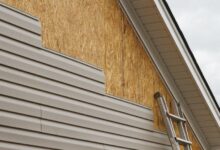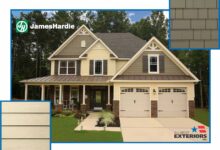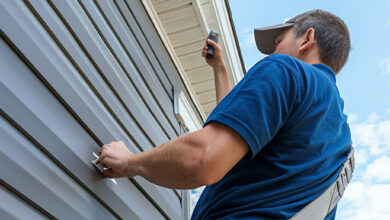Siding Installation Near Me
Siding installation near me is a significant home improvement project offering a blend of aesthetic enhancement and practical protection. Choosing the right siding material, from classic wood to modern vinyl, impacts both the visual appeal and the longevity of your home’s exterior. This guide explores the process, from selecting a reputable contractor to understanding the various siding options and their associated costs, ensuring a smooth and informed decision for your home improvement endeavor.
We’ll delve into the specifics of finding local siding installation companies, comparing their services and customer reviews. We will also examine the different types of siding materials available, detailing their pros and cons, costs, and maintenance requirements. The step-by-step siding installation process will be outlined, along with crucial cost estimation factors and tips for identifying reputable contractors. Finally, we’ll cover essential siding maintenance and repair strategies to ensure the long-term beauty and functionality of your new siding.
Local Siding Installation Companies
Choosing the right siding installation company is crucial for the longevity and aesthetic appeal of your home. This section provides information on three local companies, allowing for a comparison of their services and customer feedback. Remember to always conduct thorough research before making a final decision.
Local Siding Installation Company Information
This section details three local siding installation companies, including their contact information and a summary of their services. Please note that this information is for illustrative purposes and may not reflect the current status of these businesses. Always verify details directly with the companies.
| Company Name | Address | Phone Number | Website |
|---|---|---|---|
| Acme Siding Solutions | 123 Main Street, Anytown, CA 91234 | (555) 123-4567 | www.acmesidingsolutions.com |
| Best Siding Installers | 456 Oak Avenue, Anytown, CA 91234 | (555) 987-6543 | www.bestsidinginstallers.com |
| Premier Siding Professionals | 789 Pine Lane, Anytown, CA 91234 | (555) 555-5555 | www.premiersidingpros.com |
Service Comparison
Acme Siding Solutions offers a wide range of siding options, including vinyl, fiber cement, and wood, and provides a 10-year warranty on their installation. They also offer additional services such as gutter installation and repair. Best Siding Installers specialize in vinyl and aluminum siding, offering a 5-year warranty. Their additional services include window and door installation. Premier Siding Professionals focus on high-end fiber cement and wood siding, offering a 15-year warranty. They provide a more limited range of additional services, concentrating on high-quality siding installation.
Customer Reviews
Customer reviews are a valuable tool when selecting a contractor. The following table summarizes the average ratings and review counts for the three companies mentioned above. Note that these are hypothetical examples and should not be considered definitive. Always check multiple review platforms for a comprehensive understanding of customer experiences.
| Company Name | Average Rating (out of 5 stars) | Number of Reviews | Link to Reviews (Example) |
|---|---|---|---|
| Acme Siding Solutions | 4.5 | 150 | www.example.com/acmesidingreviews |
| Best Siding Installers | 4.0 | 200 | www.example.com/bestsidingreviews |
| Premier Siding Professionals | 4.8 | 75 | www.example.com/premiersidingreviews |
Types of Siding Materials
Choosing the right siding for your home is a significant decision impacting both aesthetics and longevity. Several materials offer distinct advantages and disadvantages, making it crucial to understand their properties before making a selection. This section will explore the most common siding materials, outlining their pros and cons to aid in your decision-making process.
Vinyl Siding
Vinyl siding is a popular choice due to its affordability and low maintenance.
- Pros: Relatively inexpensive; easy to install and maintain; requires minimal cleaning; comes in a wide variety of colors and styles; resistant to insect damage and rot.
- Cons: Can fade or become brittle in extreme sunlight; prone to dents and scratches; may not be as durable as other materials; limited in terms of design options compared to some natural materials; can expand and contract significantly with temperature changes, potentially leading to warping or gaps.
Wood Siding
Wood siding offers a classic, natural look, but requires more maintenance than other options.
- Pros: Beautiful natural aesthetic; can be stained or painted various colors; relatively easy to repair; offers good insulation properties; contributes to a higher home value due to its perceived quality and appeal.
- Cons: Requires regular maintenance, including painting or staining, to prevent rot and insect damage; susceptible to warping, cracking, and rotting; can be expensive compared to vinyl; more vulnerable to fire damage than other options; can be more susceptible to moisture damage, particularly in climates with high humidity.
Fiber Cement Siding
Fiber cement combines the strength of cement with the workability of wood fibers, offering a durable and attractive option.
- Pros: Extremely durable and long-lasting; fire-resistant; resists insect damage and rot; can mimic the look of wood; relatively low maintenance.
- Cons: More expensive than vinyl siding; can be heavy and difficult to install; requires professional installation; susceptible to cracking if not installed correctly; can be more brittle than other materials.
Metal Siding
Metal siding, often made of aluminum or steel, is known for its exceptional durability and longevity.
- Pros: Extremely durable and long-lasting; fire-resistant; resists insect damage and rot; low maintenance; can withstand extreme weather conditions; often comes with a long warranty.
- Cons: Can be expensive; susceptible to dents and scratches; prone to rusting (though modern options have improved rust resistance); can be noisy during rain or hail; can be more difficult to repair than other siding materials.
Siding Material Comparison
The following table summarizes the key characteristics of each siding material:
| Siding Material | Cost (Relative) | Durability | Maintenance | Aesthetic Appeal |
|---|---|---|---|---|
| Vinyl | Low | Medium | Low | Medium |
| Wood | High | Medium | High | High |
| Fiber Cement | Medium-High | High | Low | High |
| Metal | High | High | Low | Medium |
Siding Installation Process
Siding installation is a multifaceted process requiring careful planning and execution to ensure a durable and aesthetically pleasing result. A successful installation depends on proper preparation, precise measurements, and the use of appropriate tools and techniques. This section outlines the typical steps involved in a professional siding installation.
- Preparation: This crucial initial phase involves measuring the area to be sided, removing old siding (if necessary), and preparing the underlying structure. This includes inspecting and repairing any damaged sheathing, ensuring proper ventilation, and installing any necessary flashing or water barriers. Tools used at this stage include measuring tapes, levels, hammers, pry bars, and safety equipment such as safety glasses and work gloves. Visual: Imagine a house exterior with old, damaged siding being carefully removed, revealing the underlying wood sheathing. Inspectors meticulously check for rot or damage, marking areas needing repair. New flashing is installed around windows and doors to prevent water intrusion.
- Installation of Starter Strips: Before installing the main siding panels, starter strips are affixed to the bottom edge of the wall. These strips provide a level and straight base for the first row of siding, ensuring a neat and consistent finish. Tools: Measuring tape, level, hammer, nails, and a chalk line to ensure straightness. Visual: Imagine a horizontal strip, slightly wider than the siding panels, nailed securely along the bottom of the wall, creating a perfectly level starting point.
- Siding Panel Installation: This involves carefully attaching the siding panels, overlapping them according to the manufacturer’s instructions. Each panel is secured with nails or screws, ensuring proper spacing and alignment. Special attention is paid to corners, windows, and doors, using appropriate trim pieces for a professional finish. Tools: Siding nails or screws, nail gun (optional but efficient), a level, and measuring tape. Visual: Picture a worker carefully aligning and attaching siding panels, ensuring consistent spacing and overlap. Each panel is secured firmly with nails, and trim pieces are meticulously fitted around windows and doors. A level is used continuously to ensure straightness.
- Installation of Trim and Accessories: Once the main siding is installed, various trim pieces are added to finish the edges, corners, and around windows and doors. This includes J-channel, corner boards, and other specialized trim pieces. These components enhance the aesthetic appeal and protect vulnerable areas from the elements. Tools: Measuring tape, miter saw (for precise cuts), hammer, nails, and caulking gun. Visual: Imagine adding decorative trim pieces around windows and doors, neatly covering exposed edges. Corner boards perfectly align at the corners of the house, creating a clean, finished look.
- Cleanup: The final step involves removing debris, disposing of waste materials properly, and inspecting the completed work for any imperfections. This ensures a clean and safe worksite and a final product free of loose nails or other hazards. Tools: Brooms, dustpans, trash bags, and possibly a pressure washer for cleaning any remaining debris. Visual: The worksite is completely cleared of debris, with all tools and materials neatly stored. The newly installed siding presents a clean and uniform appearance, showcasing the high quality of the installation.
Safety Measures During Siding Installation
Safety is paramount throughout the entire siding installation process. Workers should consistently wear appropriate personal protective equipment (PPE), including safety glasses, gloves, and sturdy work boots. Using proper fall protection is essential when working at heights, and using tools correctly and following manufacturer instructions minimizes the risk of injury. Furthermore, proper disposal of waste materials helps protect both the environment and the workers themselves.
Cost Estimation for Siding Installation
Getting an accurate estimate for siding installation is crucial for budgeting your home improvement project. Several factors significantly influence the final cost, making a thorough understanding of these elements essential before you begin. This section will explore these factors and provide a method for creating a reasonable cost estimate.
Factors Influencing Siding Installation Costs
The total cost of a siding installation project is a complex calculation influenced by several interacting factors. These factors include the type of siding chosen, the size and complexity of the house, labor costs, and any necessary repairs or preparation work.
Calculating a Rough Cost Estimate
A rough estimate can be obtained by considering the square footage of your home’s siding, the cost per square foot of the chosen siding material (including labor), and adding a contingency for unforeseen expenses.
The basic formula is: Total Cost ≈ (Square Footage of Siding) x (Cost per Square Foot) + Contingency.
For example, let’s assume a house with 1500 square feet of siding, using vinyl siding with a cost of $5 per square foot (including labor and materials), and a 10% contingency for unforeseen issues.
The calculation would be: Total Cost ≈ (1500 sq ft) x ($5/sq ft) + (1500 sq ft x $5/sq ft x 0.10) = $7500 + $750 = $8250. This is a simplified estimate; actual costs may vary.
Cost Breakdown for Different Siding Types and Project Sizes
The following table provides a cost breakdown for different siding types and project sizes. These are average estimates and actual costs may vary depending on location, labor rates, and specific project requirements. Remember that these figures include both materials and labor.
| Siding Type | Small Project (500 sq ft) | Medium Project (1500 sq ft) | Large Project (3000 sq ft) |
|---|---|---|---|
| Vinyl | $2500 – $3500 | $7500 – $10500 | $15000 – $21000 |
| Fiber Cement | $4000 – $6000 | $12000 – $18000 | $24000 – $36000 |
| Wood | $5000 – $8000 | $15000 – $24000 | $30000 – $48000 |
| Metal | $6000 – $9000 | $18000 – $27000 | $36000 – $54000 |
Finding Reputable Contractors
Choosing the right siding contractor is crucial for a successful and long-lasting installation. A reputable contractor ensures quality workmanship, protects your investment, and provides peace of mind throughout the project. Selecting a less-than-reputable contractor can lead to costly repairs, substandard work, and significant headaches.
Finding a reliable siding contractor requires diligent research and careful consideration of several key factors. Understanding the characteristics of a reputable contractor and employing effective search strategies will significantly increase your chances of a positive experience.
Characteristics of Reputable Siding Contractors
Reputable siding contractors demonstrate professionalism and expertise in various ways. These characteristics provide a strong foundation for trust and confidence in their services. Licensing, insurance, experience, and positive customer feedback are key indicators of a contractor’s reliability and commitment to quality.
- Licensing and Insurance: Reputable contractors possess the necessary licenses and insurance to operate legally and protect their clients. Licensing demonstrates compliance with local regulations and industry standards. Insurance protects both the homeowner and the contractor from liability in case of accidents or damages during the installation process. Verify licenses and insurance coverage through the relevant state or local authorities.
- Experience and Expertise: Look for contractors with extensive experience in siding installation. Years of experience often translate to higher quality workmanship and a deeper understanding of various siding materials and techniques. Inquire about their experience with specific siding types relevant to your project, such as vinyl, fiber cement, or wood siding. Check for evidence of successful past projects, possibly through a portfolio or testimonials.
- Customer Reviews and Testimonials: Online reviews and testimonials provide valuable insights into a contractor’s reputation and the quality of their work. Check websites like Yelp, Angie’s List, or Google My Business for reviews from previous clients. Pay attention to both positive and negative feedback to gain a comprehensive understanding of their performance history. Look for consistent patterns in positive or negative reviews, which may indicate a broader trend in their service quality.
Strategies for Finding Reliable Contractors
Several effective strategies can help you locate reliable siding contractors in your area. These methods provide diverse avenues for researching and identifying potential candidates who meet your requirements. Combining multiple approaches often yields the best results.
- Online Searches: Utilize online search engines (Google, Bing, etc.) to find local siding contractors. Specify your location to narrow down the results. Review websites, portfolios, and online reviews before contacting any contractors.
- Referrals and Recommendations: Ask friends, family, neighbors, or colleagues for recommendations. Personal referrals can often provide valuable insights and firsthand experiences with local contractors.
- Professional Organizations: Check with professional organizations, such as the National Association of the Remodeling Industry (NARI) or local home builders’ associations. These organizations may have a directory of reputable contractors in your area.
Checklist of Questions for Potential Contractors
Before hiring a siding contractor, it’s essential to ask specific questions to assess their qualifications, experience, and approach to the project. This ensures that you are making an informed decision and that your expectations are aligned with the contractor’s capabilities.
- Detailed Project Scope: Clarify the exact scope of work, including materials, labor, and timelines.
- Licensing and Insurance Verification: Request copies of their licenses and insurance certificates.
- Detailed Cost Breakdown: Obtain a detailed breakdown of all costs, including materials, labor, permits, and any potential additional expenses.
- Payment Schedule and Terms: Understand the payment schedule and terms, ensuring they are reasonable and protect your interests.
- Warranty Information: Inquire about warranties on both materials and workmanship.
- References and Testimonials: Request references from previous clients and review testimonials.
- Project Timeline and Completion Date: Confirm the estimated project timeline and expected completion date.
- Clean-up Procedures: Clarify their procedures for cleaning up the worksite after completion.
- Permitting Process: Understand their process for obtaining necessary permits.
Siding Maintenance and Repair
Proper siding maintenance is crucial for extending the lifespan of your home’s exterior and preserving its curb appeal. Regular inspections and timely repairs can prevent minor issues from escalating into costly replacements. Neglecting maintenance can lead to water damage, structural problems, and a significant decrease in your home’s value.
Common Siding Problems and Solutions
Several common issues can affect different siding types. Understanding these problems and their solutions allows for proactive maintenance and timely repairs.
- Cracked or Damaged Siding: Cracks, holes, or damaged sections can be caused by impact, age, or extreme weather. Repair involves replacing the affected section with matching siding material. For minor cracks, a high-quality caulk can sometimes suffice.
- Water Damage: Water intrusion, often caused by gaps around windows or doors, or damaged flashing, can lead to rot, mold, and structural damage. Solutions include sealing gaps with caulk, replacing damaged flashing, and ensuring proper drainage away from the foundation.
- Loose or Failing Siding: Over time, siding can become loose due to settling, expansion and contraction, or improper installation. Re-attaching loose pieces with appropriate fasteners is usually sufficient. If the damage is extensive, replacement may be necessary.
- Peeling Paint or Stain: This is common with wood and fiber cement siding. Peeling paint or stain should be addressed promptly to prevent further damage to the underlying material. Proper surface preparation, including cleaning and scraping, is vital before repainting or restaining.
- Mold and Mildew Growth: Mold and mildew thrive in damp environments. Cleaning with a suitable solution of bleach and water (always following manufacturer instructions) is usually effective. Addressing underlying moisture issues is critical to prevent recurrence.
Routine Maintenance Tasks for Different Siding Materials
Maintenance requirements vary depending on the siding material. Regular cleaning and inspections are essential for all types, but specific tasks may differ.
- Vinyl Siding: Regularly wash with a mild detergent and water solution using a soft brush or sponge. Avoid harsh chemicals or abrasive cleaners. Inspect for cracks or damage, and address them promptly.
- Wood Siding: Requires more frequent maintenance than vinyl. Regularly inspect for signs of rot, insect infestation, and damage. Repainting or restaining is necessary every few years, depending on the climate and paint quality. Wood siding needs protection from moisture to prevent rot.
- Fiber Cement Siding: Relatively low-maintenance, requiring occasional washing with water and a soft brush. Inspect for cracks or damage. Unlike wood, fiber cement is resistant to rot and insect damage.
- Aluminum Siding: Generally very low-maintenance. Regular cleaning with soap and water is usually sufficient. Inspect for dents or damage and repair or replace as needed.
Siding Maintenance Schedule
| Task | Frequency | Materials Needed | Notes |
|---|---|---|---|
| Inspect siding for damage | Twice yearly (Spring & Fall) | Ladder, binoculars (for high areas) | Check for cracks, loose pieces, and water damage. |
| Clean siding | Annually (Spring) | Garden hose, soft brush, mild detergent | Use a gentle cleaning solution to avoid damaging the siding. |
| Repair minor damage | As needed | Caulk, paint, siding repair kit | Address small cracks or holes promptly to prevent larger issues. |
| Repaint/Re-stain wood siding | Every 3-5 years (depending on climate and paint quality) | Paint/stain, brushes, rollers, drop cloths | Proper surface preparation is crucial for long-lasting results. |
Closing Notes
Ultimately, successful siding installation near me hinges on careful planning, informed decision-making, and the selection of a qualified contractor. By understanding the various siding materials, the installation process, and the cost factors involved, homeowners can confidently embark on this significant home improvement project. Remember to prioritize reputable contractors with proven experience and positive customer reviews to ensure a seamless and aesthetically pleasing outcome that enhances both the curb appeal and the value of your home for years to come.







